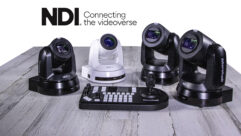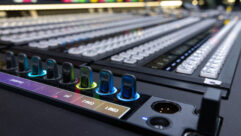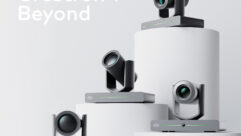
Technology Showcase: Document Cameras and Visual Presenters
Dec 1, 2007 12:00 PM,
By Bennett Liles
Knowing your unit’s capabilities is essential to a good presentation.

Samsung SDP-6500DXA
The role of the document viewer has expanded and morphed into that of a multifaceted presentation center, and the technology’s name has evolved right along with it. From the overhead projector to the document camera to the visual presenter, the device has leaped from the table to the ceiling, added digital storage, and become an online broadcast tool.
The best thing about these products is that, for the most part, during their several decades of evolution, manufacturers haven’t thrown away any capabilities on these devices, but they’ve added many. The most modern visual presenters can still show transparencies with razor-sharp detail, but they can also store each image, record a presenter’s voice, and send both around the world on IP packets.
USER CHALLENGES
The challenge to users is to know the territory on all those capabilities, what works best for the content planned, how to smoothly transition from one mode to another, and of course, which signal from what device attaches to each connection point. Without a thorough understanding of the document camera’s or visual presenter’s capabilities, it is very easy for an otherwise carefully planned presentation to quickly degenerate into an inadvertently comical and frustrating demonstration on what not to do.
Quite possibly the most useful new feature on the modern visual presenter is the image-storage capability. Instead of showing up for a presentation with an armload of paper documents and folders, the operator has stored the images either inside the unit, on a flash drive, or on a computer ready for recall. Of course, the growing variety of video formats has required these products to evolve rapidly to keep pace, and most include composite and S-Video, along with RGB outputs in various resolutions. Some provide DVI ports, and a few even provide resolution and aspect-ratio switching. Most have at least some capability to act as the coordinating element in a multimedia presentation, with instant selection between live images from the camera, stored images, and video clips from external players and Internet sources through an Ethernet RJ-45 port.
The vastly extended range of settings and combinations of options has necessitated configuration presets. This can compensate for more inexperienced users because it allows a user that is more familiar with the options and their applications to set up configuration in advance. Thus, a less sophisticated operator can run a presentation using only a few configuration recall buttons and look like a pro. Still, it benefits presenters to familiarize themselves with the features of the unit to avoid getting into a situation where they end up fighting the technology designed to make their presentations simpler. It doesn’t take long for the average document-camera user to learn how to use the autofocus feature to provide an initial sharp image, and then switch to manual focus to avoid having the autofocus go wild when the user’s hand comes into frame to move or replace a printed page. Three-dimensional objects can also require the switch to manual focus at times, but these tips will come naturally with experience. Meanwhile, let’s have a look at what’s currently available.
OPTIONS AVAILABLE
With an 850,000-pixel progressive scan CCD at 30fps, the JV-850K from Alliance International includes a USB 2.0 port so that the images captured by the document camera can be displayed on a computer. The optional Digital Class LCD annotation tablet enables the operator to draw and write notes over any object displayed, and the annotated images can also be saved. The lens includes a 10X digital zoom and a 16X optical zoom. The camera can be rotated for viewing oversized objects, and up to 16 images may be saved internally. Included are two RGB outputs, an S-Video output, a composite output, one RGB input, a microphone input, and an audio output. Mouse control and infrared remote are included, and the remote control stores inside the unit. Up to four user settings can also be stored. The JV-850K retails for $2,995.
The highly mobile and compact AVerVision SPC300 Premium from AVerMedia sports a fast autofocus with a 3.2-megapixel sensor, 3X optical zoom, 2X AVerZoom, and 8X digital zoom/pan. Featuring splitscreen and picture-in-picture, the unit also provides AVerPointer, AVerBox, and AVerVisor functions, and it shows these in a 24fps rate with an output resolution of 1024×768. Up to 80 images can be saved internally with thumbnail image reference and timed slideshow viewing, or they can be saved on an SD card. Video and images may also be fed through a USB port and stored on a computer. Video outputs include S-Video, composite, DVI, and VGA. There is also a VGA pass-through input for integrating computer material into a presentation. Infrared and RS-232 remote control is provided, along with image freeze, rotation, and mirror functions. Auto/manual white balance, focus, and exposure allow the look of any presentation to be customized, and a TV/VGA switch completes the control array. Optional accessories include a padded carrying bag, a microscopic adapter, and a laser-positioning guide adapter. The SPC300 retails for a little more than $1,000.
In addition to being light and rugged enough to be truly portable, the Boxlight BV1100 visual presenter can serve as the central element in a complete multimedia production. A 220X auto/manual zoom can focus on the tiniest objects, and its CCD head rotates 180 degrees vertically and 270 degrees horizontally. With one mic input, two line audio inputs, and two video inputs, the BV110 can coordinate and switch through virtually any array of video sources and output these through S-Video, two composite video, and two audio outputs. A 410,000-pixel, 470-horizontal-line picture complements the ample zoom capability down to 0.5 lux. Video is switchable between color and monochrome, and the unit offers auto and manual white balance. Controlled through keypad, IR remote, or RS-232, the BV1100 includes image storage and carries a price tag of $899.

Casio YC-430
The YC-430 multifunctional camera system from Casio offers a mobile solution for projecting documents and 3D objects. Incorporating a 1 1/8in. square pixel CCD, the camera presents an effective 10.1 megapixels, 3X optical zoom, 22X digital zoom, autofocus, and a scanner for copying and saving documents. Features include an automatic alignment function that will ensure a neatly lined-up picture once the document is placed in the specified position. Configurable with a laptop computer, the YC-430 connects to the computer with a USB 2.0 port for projection. The unit can fold up to fit inside a briefcase, and it weighs only 3.5lbs. The camera can be detached from the unit and used independently. Shutter speed, aperture, and white balance are all automatic, and controls include PC/camera switching. Provided with the unit are a Lithium-ion battery, a carrying bag, a USB cable, an AC adapter, and an AV cable for the camera.
Smaller than most table lamps, the bright red Dukane Camera 335 has a distinctive appearance and innovative control layout with video connectors around the periphery of the base and a circular, top-mounted control pad. A 1/3in. progressive-scan CCD provides 1024×768 XGA resolution at 20fps, auto/manual exposure control, auto white balance, autofocus with a 16X digital zoom, 10X optical zoom, and freeze. The unit may be operated in normal-, film-, and gray-image modes with either photo or text gamma settings. The DVI pass-through allows computer/visualizer switching, and the internal storage can handle up to 64 frames. The outputs include VGA, DVI, composite, and USB for computer connection. A RS-232 remote connects with a 3.5mm stereo mini jack. Included is image-capture software affording fullscreen image reviewing, annotation, and capture. Accessories include VGA, USB, and C-Video cable; a user manual; and a remote.

Elmo P100
Longtime industry leader Elmo has introduced the P100 document camera featuring enhanced image detail for documents and 3D objects with a 4X digital zoom, 16X optical zoom, a 1.3-million-pixel CMOS image sensor, and 30fps frame speed for smooth motion. HDTV-ready, the P100 is small enough to be easily portable, supports progressive-scan video formats at an output resolution of 1280×720 pixels, and allows splitscreen display of live and stored images. For sharp display of text pages, the unit offers a clear-text mode that accentuates black-and-white contrast. The company touts a one-finger-setup capability that complies with the federal Americans with Disabilities Act (ADA) requirements. The unit can be used in conjunction with smart boards through a USB 2.0 connection, and it can store up to 2,000 images on an SD card. One-button autofocus and other controls are located on an LCD screen at the operator’s right hand. The P100 retails for $3,465.
The Epson ELPDC05 high-resolution document camera is a tool for users who make frequent presentations and need advanced features. The unit offers a combined 18X optical and 2X digital zoom range, 20fps frame speed, auto/manual white balance, autofocus, auto iris, gamma selection for low-light situations, Clear Screen/Image mode, and color/monochrome selection for blueprints and X-rays. Imaging is provided by a 1/3in. 850,000-pixel CCD. In addition to the built-in base light, there are two foldout arms with 6W fluorescent lamps to light objects from above. For multisource presentations, there is RGB switching between two sources, an RS-232 control port for remote operation, and a wireless remote that stores inside the unit. Also featured are object freeze, image scrolling, negative/positive conversion, and an arrow pointer to aid in presentation. The outputs are composite and S-Video. The Epson ELPDC05 retails for $3,795.
The Ken-A-Vision DocCam Pro AV provides portability for presenters who encounter a wide variety of venues and setup challenges. With no stage, the unit has a camera on a two-section telescoping neck and flexible overhead LED arm lights to show documents and objects on the same flat surface on which the product rests. Operational features include automatic iris, focus, shutter, and white balance, along with a 16X zoom lens and both S-Video and composite video pass-throughs for integration with external video sources. Adjustable stereo microphones allow for presenter voice pickup. The CCD outputs a 450-line horizontal-resolution picture down to 3-lux illumination. A remote control allows the presenter to move around during the presentation. The MSRP for the DocCam Pro AV is $2,295.
The PS600 desktop document camera from Lumens features a splitscreen capability, which allows a previously-stored image to be displayed beside the camera’s live picture. The 12X zoom and 22fps frame rate, with realtime progressive output, allows smooth video when demonstrating and manipulating three-dimensional objects. The unit can also accept a computer VGA output for computer/live demos, and it outputs the video in composite, VGA, and DVI. Up to 64 JPEG images may be directly captured from computers through USB and Ethernet ports and stored on or displayed from a CF card. A 9-pin com port allows RS-232 remote control, and a mouse port is available. The PS600 also features auto/manual white balance, exposure control, and focusing. The camera head rotates 90, 180, and 270 degrees for operation in photo, text, slide, film, gray, and microscope modes with freeze function. The PS600 can be found for around $1,700.
The ProMax DG880 digital visual presenter uses a 1/3in. CCD for XGA resolution and features a 12X optical zoom and a 10X digital zoom, along with 20fps frame speed. The camera head rotates 330 degrees vertically. The unit can also be used along with external video sources with its two RGB in/out ports, an S-Video I/O, and a composite video I/O. No external switching is necessary because the external sources can all be output to the projector through the RGB output connection. Up to nine images can be saved, and these can be displayed side-by-side in a splitscreen mode with live images on the display platform, and with image freeze and rotate capability. Additionally, the DG880 has a built-in projector control for any make or model. LED side lamps are billed to last up to 10 years, and there is also a wireless remote control that stores inside the unit. For image storage and recall from a computer, a USB 2.0 port is also provided. The motorized camera head affords pushbutton image scrolling. The DG880 can be found for just more than $2,000.
With four separate video inputs, the Qomo QD1600 digital visual presenter can be the control center of a whole multimedia event. Along with its own camera video, the unit can input two external RGB sources, an S-Video, and a composite video player simultaneously. These sources are output on one cable to a projector or monitor display, which can be RS-232-controlled by the presenter. The QD1600 can also be operated with third-party control systems. The high-speed autofocus, white balance, and iris features accompany the 16X digital and 10X optical zoom. The adjustable LED lamps control lighting angle and last up to 10 years. Other features include emboss conversion, edge conversion, image mirror, rotate and flip, picture-in-picture, 16-image save and recall, camera mouse, color/monochrome selection, and microphone and computer audio inputs. The QD1600 can be found for less than $2,000.
The Samsung SDP-6500DXA premium digital presenter incorporates a 1.5-megapixel, 1/2in.-CCD camera with a 12X optical zoom and 3X digital zoom at 15fps and 1280×1024 resolution. Features include auto and manual focus, white balance, and automatic iris control. Image freeze is available, along with negative/positive image selection and image rotation. Input selection is switchable between the camera and two external VGA sources. Up to eight frames may be stored for recall, and up to four user presets may be set up. Images may be transferred to and from a computer with the USB 2.0 connection. Remote control is possible through RS-232C or with the supplied infrared remote. For optimum display picture quality, a DVI output connection is also provided. The unit provides an internal base light and top lights on its adjustable arms. The SDP-6500DXA can be found for less than $3,500.
The Vaddio CeilingView HD is a high-definition, ceiling-mounted visualizer designed for use where image quality and resolution are critical. The CeilingView HD can be configured for 16:9 HD resolutions of 1080i or 720p when using the analog component video outputs (Y/Pb/Pr), or 4:3 standard-video resolutions with S-Video and composite video outputs. Equipped with a 10X optical motorized zoom lens and 12X digital zoom range, the camera has a combined 120X zoom capability. The 1/3in. CMOS image sensor has approximately two million pixels, and it provides precise color reproduction and edge focus, which is essential for displaying images on a large-format HD monitor or projector. Vaddio’s active EZ Camera Pro series cabling system uses high-speed differential signaling (HSDS) for the video signals from the camera module to the Quick-Connect CV HD/SD interface as opposed to baluns. This gives this system high-definition and standard-definition video capability, along with superior video quality over Cat-5 cabling.
The WolfVision VZ-57 Plus incorporates a positioning feature called the Synchronized Lightfield, a lighted area that exactly duplicates the area covered by the lens. When the camera is zoomed in, the Lightfield shrinks to maintain the same coverage area seen in the lens, allowing rapid document positioning and setup. The picture is produced by a 1/3in. 3CCD progressive-scan imager with 2.5 megapixels at 30fps, and it offers a 12X optical zoom with macro and a 4X digital zoom. The VZ-57 Plus features auto/manual white balance and iris, a text enhancer that increases black-and-white contrast, and an onscreen menu. There are LAN and USB ports, nine image memories, manual and autofocus, PAL and NTSC output standards, and a 15-pin RGB input. Remote control is possible through both infrared and RS-232. Output modes range from 640×480 to 1920×1080, and there are also S-Video, DVI, and composite video output ports. The unit also provides an automatic lamp changer that indicates “changing lamp” on the display screen as it functions.
For More Information
Alliance International
www.alliance-intl.com
AVerMedia
www.aver.com
Boxlight
www.boxlight.com
Casio
www.casio.com
Dukane
www.dukcorp.com
Elmo
www.elmousa.com
Epson
www.epson.com
Ken-A-Vision
www.ken-a-vision.com
Lumens
www.mylumens.com
ProMax
www.promax-tech.com
Qomo
www.qomo.com
Samsung
www.samsung.com
Vaddio
www.vaddio.com
WolfVision
www.wolfvision.com










